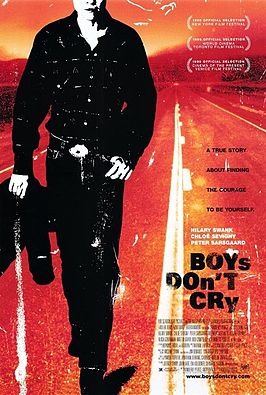
Boys Don’t Cry Poster
Boys Don’t Cry carries from start to finish with an emphasis on light, perspective, violence, and deception. One thing to note especially about Boys Don’t Cry is the beginning and ending are the same: the audience is given a car on a dark highway, traveling to anywhere, driven by a female character. The lights are out of focus and what is dark surrounds. This set-up and finish could be symbolism of the protagonist Teena “Brandon” Brandon. Hilary Swank, who pulls off a Justin Bieber/young Matt Damon in this film, is astonishingly believable as a soon-to-be F to M gendered person. She moves in the night, in the shadows, sans good light, and those around her can’t really pin-point her basis, or what she actually is. Her foundation is out of focus. Peirce captures this incredibly well, and that is what makes this movie so gripping, its honesty. The audience does not know what is coming next… That is honest. Life is not scripted, anything can happen. It could be physical violence, romantic sexual expression, or a drunken domestic outburst centered round the most sacred part of the house, a living room. The beauty of Boys Don’t Cry is the reality it mimics, the unknown- and not knowing.
Sexuality within the film focuses on “Brandon” trying to find love, find himself/herself, while moving around just trying to exist, survive. He deceives all those around him by not being straightforward about his situation; he is not a man. Brandon comes into a precarious situation by way of alcohol and drugs, and probably chance. The audience is taken in, first-hand, as Brandon is. He build relationships and is pitted against what would seem “normal” or “average” antagonists, against an ambivalent character. Brandon tries to be macho in respect to Lana’s ex-lover, felon, Brandon tries to win the heart of Lana. Role reversals within Boys Don’t Cry seem shocking; Brandon is raped (as a woman), Lana is intrigued that Brandon is actually female, and the drunken mother. I think the message within the film is that there is a duality to each situation. It is not so much about labels, blame, or deception (everyone is to blame within Boys Don’t Cry), but rather how it makes you feel, and for what purpose. That is the most important bit.
Lana and Brandon seemed in love, as opposed to Lana and her ex-lover, total drunk loser. There was a peace in the atmosphere when Lana was with Brandon that took her out of the “Hell” which was her living situation. And that all came to a violent end.
Kimberly Peirce’s directing utilizes fast cuts and manipulated lighting, not to mention the set, makeup, and overall appeal of the environment which is being imagined. It appears to me that most of the scenes take place at night or in the dark, or in sorted establishments. This filter affects one’s perception of reality, characters who appear in the dark, are not as they appear during the day. Fast cuts emphasize the fast pace of the movie, there exists this whirlwind love affair which is bound to become disastrous and volatile. Swank’s general presence gave me an uneasy feeling; I wonder, if one can be so convincingly conjured that no one is to know the difference, who around us is real? And what is “real”? Does it matter as much as the feeling that individual gives off? This not knowing of what is “real” creates the tension that eventually leads to the climactic ending.
The culmination of the film was shocking; people got shot, in the head. The interesting thing is the passing of the torch at the end. We have another character touched so much by Brandon’s ambition, concepts, and love that she embarks on what was to be his journey. The dangers of deception, manipulation, and drunken violence transcend intent (as good as it may have been), hence why Brandon was eventually killed. Boys Don’t Cry is a powerful film with a poignant and tragic message; people are still concerned with labels and other peoples’ sexual preferences, so much so that they will carry out violent acts in retaliation.


